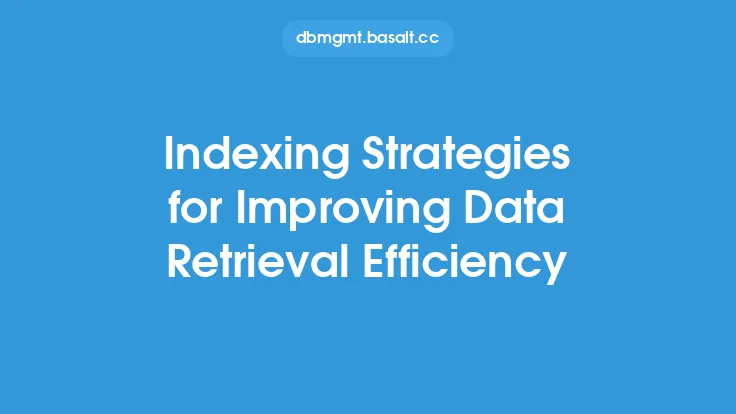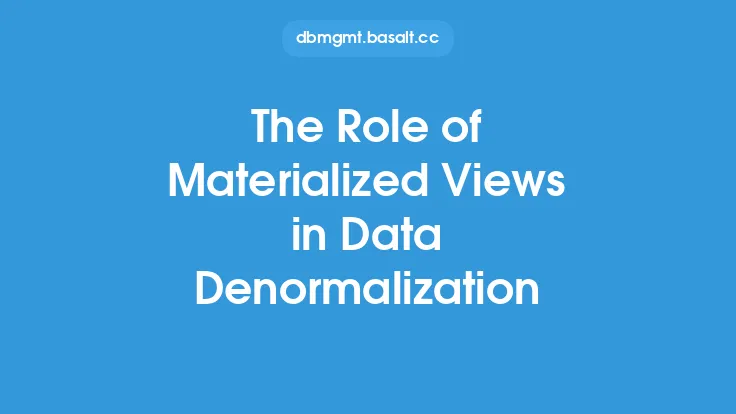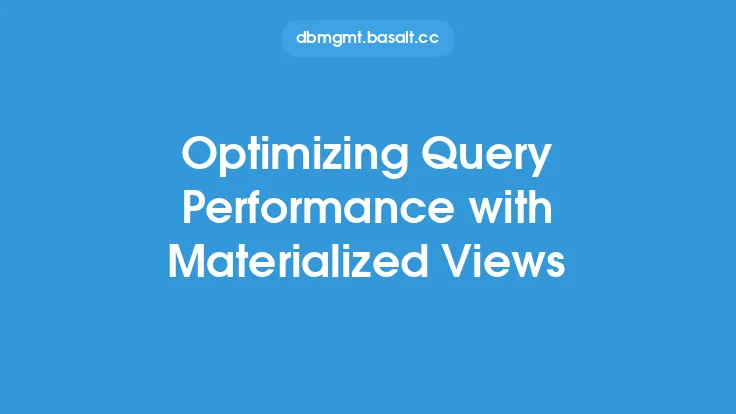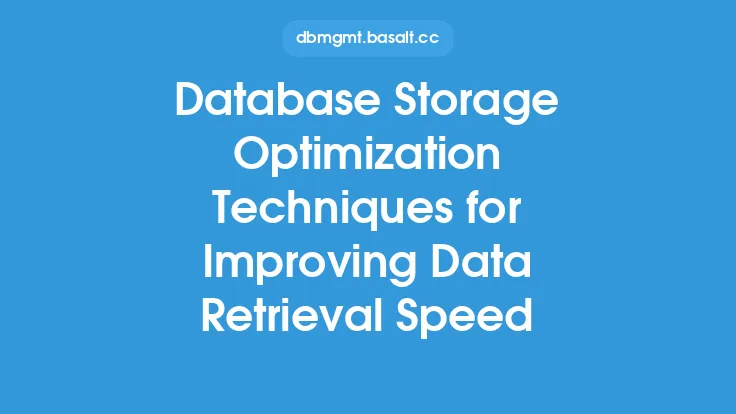Data retrieval efficiency is a critical aspect of database management, as it directly impacts the performance and responsiveness of applications and services that rely on the data. One technique that can significantly improve data retrieval efficiency is the use of materialized views. A materialized view is a physical table that stores the result of a query, allowing the database to retrieve the data directly from the table instead of having to execute the query every time it is requested.
Introduction to Materialized Views
Materialized views are designed to improve query performance by pre-computing and storing the results of complex queries. This approach can be particularly useful for queries that involve multiple joins, subqueries, or aggregate functions, as these types of queries can be computationally expensive and time-consuming to execute. By storing the results of these queries in a materialized view, the database can avoid having to re-execute the query every time it is requested, resulting in faster query performance and improved data retrieval efficiency.
How Materialized Views Work
Materialized views work by storing the result of a query in a physical table. When a query is executed against the materialized view, the database can retrieve the data directly from the table instead of having to execute the query. This approach can significantly improve query performance, as the database does not have to spend time and resources executing the query. Instead, it can simply retrieve the pre-computed results from the materialized view.
Benefits of Materialized Views
The use of materialized views can provide several benefits, including improved query performance, reduced computational overhead, and enhanced data retrieval efficiency. By pre-computing and storing the results of complex queries, materialized views can help to reduce the load on the database, resulting in faster query performance and improved responsiveness. Additionally, materialized views can help to improve data consistency, as the data is stored in a single location and can be easily updated and maintained.
Types of Materialized Views
There are several types of materialized views, including simple materialized views, complex materialized views, and partitioned materialized views. Simple materialized views are the most basic type of materialized view and store the result of a single query. Complex materialized views, on the other hand, store the result of multiple queries and can be used to support more complex data retrieval scenarios. Partitioned materialized views are a type of materialized view that is divided into smaller, more manageable pieces, allowing for more efficient data retrieval and storage.
Creating and Maintaining Materialized Views
Creating and maintaining materialized views requires careful planning and consideration. The first step in creating a materialized view is to identify the query or queries that will be used to populate the view. The query or queries should be optimized for performance and should not include any volatile functions or variables. Once the query or queries have been identified, the materialized view can be created using a CREATE MATERIALIZED VIEW statement. The materialized view should be regularly updated and maintained to ensure that the data remains consistent and up-to-date.
Materialized View Refresh Methods
There are several methods that can be used to refresh a materialized view, including full refresh, incremental refresh, and log-based refresh. A full refresh involves re-executing the query or queries that populate the materialized view and replacing the entire contents of the view. An incremental refresh, on the other hand, involves updating only the rows that have changed since the last refresh. Log-based refresh involves using a log file to track changes to the underlying data and updating the materialized view accordingly.
Materialized View Indexing
Indexing is an important aspect of materialized view maintenance, as it can significantly improve query performance. There are several types of indexes that can be created on a materialized view, including b-tree indexes, hash indexes, and bitmap indexes. The type of index that is used will depend on the specific requirements of the materialized view and the queries that are executed against it.
Materialized View Partitioning
Partitioning is a technique that can be used to divide a materialized view into smaller, more manageable pieces. This can be useful for large materialized views that are difficult to manage and maintain. There are several types of partitioning that can be used, including range partitioning, list partitioning, and hash partitioning. The type of partitioning that is used will depend on the specific requirements of the materialized view and the queries that are executed against it.
Materialized View Security
Security is an important aspect of materialized view management, as it can help to protect sensitive data and prevent unauthorized access. There are several techniques that can be used to secure a materialized view, including encryption, access control, and auditing. Encryption involves encrypting the data in the materialized view to prevent unauthorized access. Access control involves granting or denying access to the materialized view based on user identity or role. Auditing involves tracking and logging all access to the materialized view to detect and prevent security breaches.
Best Practices for Materialized Views
There are several best practices that can be followed to ensure that materialized views are used effectively and efficiently. These include optimizing queries, using efficient refresh methods, indexing and partitioning the materialized view, and securing the materialized view. Additionally, it is important to regularly monitor and maintain the materialized view to ensure that it remains consistent and up-to-date.
Common Use Cases for Materialized Views
Materialized views can be used in a variety of scenarios, including data warehousing, business intelligence, and real-time analytics. In data warehousing, materialized views can be used to pre-compute and store complex queries, improving query performance and reducing computational overhead. In business intelligence, materialized views can be used to support ad-hoc queries and reporting, providing fast and efficient access to data. In real-time analytics, materialized views can be used to support real-time data processing and analysis, providing fast and efficient access to data.
Conclusion
Materialized views are a powerful technique that can be used to improve data retrieval efficiency and query performance. By pre-computing and storing the results of complex queries, materialized views can help to reduce the load on the database, resulting in faster query performance and improved responsiveness. Additionally, materialized views can help to improve data consistency, as the data is stored in a single location and can be easily updated and maintained. By following best practices and using materialized views effectively, organizations can improve their data retrieval efficiency and support a wide range of data-intensive applications and services.





